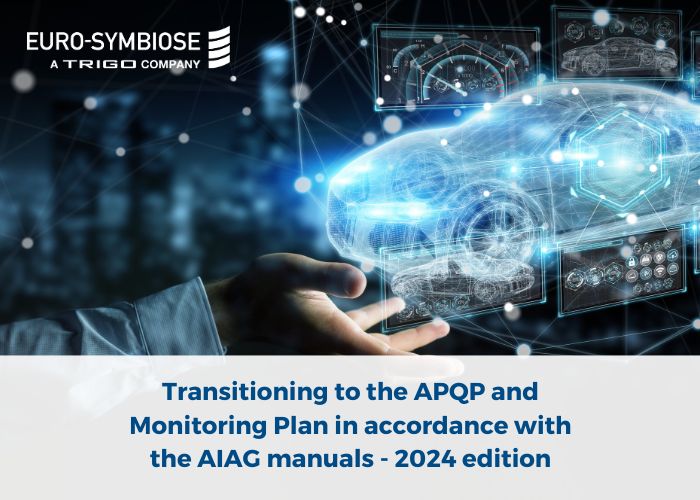Transitioning to the APQP and Monitoring Plan in accordance with the AIAG manuals – 2024 edition

With technological advances and the complexity of vehicles (autonomous, connected and electric), AIAG considered it necessary to review the APQP project management method, and to create a separate manual for the Monitoring Plan.
This change is the result of feedback on the quality of parts purchased and the launch of new products. It was developed in collaboration with Ford, General Motors and Stellantis.
While the objective of APQP has not changed, i.e. to ensure that developments meet customer requirements and expectations in terms of Quality-Cost-Delivery, and thus improve customer satisfaction, the 3rd edition of the APQP manual reinforces several aspects of the product development process.
Firstly, the involvement of management has been strengthened, through the passage of milestones which are summarised and formally approved by a ‘governance of the product development process’ (leadership support), i.e. at a level above project management.
At the end of each milestone, the project data is updated (schedule, indicators, etc.), along with lessons learned and best practices, so that they can be incorporated into the generic or family FMEAs.
The checklists for each phase have been reviewed on the basis of feedback and completed. A checklist specific to phase 0 has been added concerning the project’s general risk factors. These checklists help the project team to prepare its risk analysis, which must be presented to the project governance at each milestone.
Procurement planning is carried out further upstream, with the addition of a specific checklist. Criteria for identifying high-risk suppliers are proposed, along with steering and risk reduction actions and specific reviews with the customer.
Numerous other sections have been added, covering :
- Capacity assessment (contractual volume) and planning ;
- Change management at each phase up to APQP approval, with an associated checklist;
- Steering the APQP programme using appropriate indicators to monitor the successful execution of the tasks and phases of the programme;
- The concept of Risk Evaluation and Reduction Strategy (REMS), which represents an evolution from the risk minimisation action plans previously required.
New analytical techniques are proposed, such as a monitoring plan specific to CS, a simultaneous design process to facilitate maintenance, including vehicle diagnostics, assessment of overall equipment effectiveness (OEE), traceability, and additions on anti-error systems. The QFD and the characteristics matrix have also been removed.
Finally, four IQC manuals have been referenced: IQC 8, IQC 14, IQC 19 and IQC 28.
The aim of all these changes is to ensure a more comprehensive and better controlled approach to project management.
The AIAG ‘Surveillance Plan’ manual is now decoupled from the APQP manual, which underlines its importance. Indeed, surveillance plans were often the subject of non-conformities during IATF audits (top ten non-conformities identified by the International Automotive Bureau de surveillance (IAOB)), which motivated the creation of this manual.
The most notable change is the more detailed and comprehensive description of how to draw up, update and use a Monitoring Plan.
Previously, the contents of the form’s fields were simply described. Now, the expectations are detailed for each element, particularly with regard to monitoring frequencies and the reaction plan.
A new requirement concerns ‘safe launch’, which corresponds to additional controls implemented at series start-up, and at the customer’s request in pre-production, which must appear in the monitoring plan. A criterion is proposed for stopping these controls.
In addition to product, process and special characteristics, a new category of characteristic has been added: the Pass-Through characteristic.
The manual specifies how to show rework and repair processes.
In line with the AIAG-VDA FMEA, the conditions for establishing a generic or family monitoring plan are specified.
It should be noted that all stages of the process must be included, particularly the storage and handling stages.
The monitoring plan can be adapted for new, highly automated manufacturing processes linked to new technologies integrated into the automotive industry.
Finally, to maintain the monitoring plan during production, the manual makes the link with the tools and methods required by certain manufacturers, such as LPA and reverse FMEA.
For Ford, GM and Stellantis, the manufacturers behind these new manuals, implementation must be completed by October 2024 (6 months after publication). For other manufacturers, be sure to keep an eye on developments in their CSRs.
By taking part in the one-day training course ‘AIAG APQP 3rd edition and Surveillance Plan 1st edition (TRANSITION) – # 330’, you will understand the main changes, improvements and advantages compared with the 2nd edition of the APQP manual, and the new features in terms of the Surveillance Plan. At the end of this course, you will be able to develop a transition plan for compliance with these new AIAG manuals.
📅 Register for the next training sessions: 6 June, 17 July, or 6 September 2024
Author of this article:

Valérie LE COUËDIC Technical Director – Consultant and trainer EURO-SYMBIOSE